Tunnel
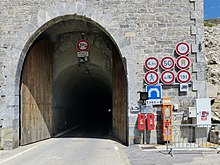
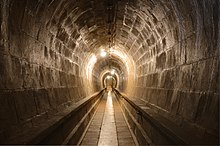
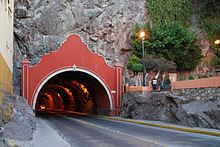
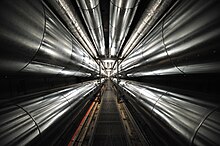
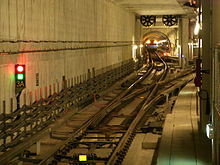

Atunnelis an underground or undersea passageway. It is dug through surrounding soil, earth or rock, or laid under water, and is usually completely enclosed except for the twoportalscommon at each end, though there may be access and ventilation openings at various points along the length. Apipelinediffers significantly from a tunnel,[1]though some recent tunnels have usedimmersed tubeconstruction techniques rather than traditional tunnel boring methods.[2]
A tunnel may be for foot or vehicularroadtraffic,forrailtraffic, or for acanal.The central portions of arapid transitnetwork are usually in the tunnel. Some tunnels are used assewersoraqueductsto supply water for consumption or forhydroelectricstations.Utility tunnelsare used for routing steam, chilled water, electrical power or telecommunication cables, as well as connecting buildings for convenient passage of people and equipment.[3]
Secret tunnelsare built for military purposes, or by civilians forsmugglingofweapons,contraband,orpeople.[4]Special tunnels, such aswildlife crossings,are built to allow wildlife to cross human-made barriers safely.[5]Tunnels can be connected together intunnel networks.
A tunnel is relatively long and narrow; the length is often much greater than twice thediameter,although similar shorter excavations can be constructed, such as cross passages between tunnels. The definition of what constitutes a tunnel can vary widely from source to source. For example, in the United Kingdom, a road tunnel is defined as "a subsurface highway structure enclosed for a length of 150 metres (490 ft) or more."[6]In the United States, theNFPAdefinition of a tunnel is "An underground structure with a design length greater than 23 m (75 ft) and a diameter greater than 1,800 millimetres (5.9 ft)."[7]
Etymology
[edit]The word "tunnel" comes from theMiddle Englishtonnelle,meaning "a net", derived fromOld Frenchtonnel,a diminutive oftonne( "cask" ). The modern meaning, referring to an underground passageway, evolved in the 16th century as a metaphor for a narrow, confined space like the inside of a cask.[8]
History
[edit]This sectionneeds expansion.You can help byadding to it.(March 2013) |
Some of the earliest tunnels used by humans werepaleoburrowsexcavated by prehistoric mammals.[9]
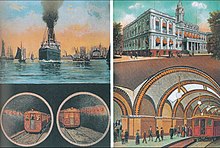
Much of the early technology of tunneling evolved fromminingandmilitary engineering.The etymology of the terms "mining" (for mineral extraction or forsiege attacks), "military engineering",and"civil engineering"reveals these deep historic connections.
Antiquity and early middle ages
[edit]Predecessors of modern tunnels wereaditsthat transported water forirrigation,drinking, orsewerage.The firstqanatsare known from before 2000 BC.
The earliest tunnel known to have been excavated from both ends is theSiloam Tunnel,built inJerusalemby the kings ofJudaharound the 8th century BC.[10]Another tunnel excavated from both ends, maybe the second known, is theTunnel of Eupalinos,which is a tunnelaqueduct1,036 m (3,400 ft) long running through Mount Kastro inSamos,Greece. It was built in the 6th century BC to serve as anaqueduct.
InEthiopia,theSiqurto foot tunnel,hand-hewn in the Middle Ages, crosses a mountain ridge.
In theGaza Strip,the network of tunnels was used by Jewish strategists as rock-cut shelters, in first links to Judean resistance against Roman rule in theBar Kokhba revoltduring the 2nd century AD.
Geotechnical investigation and design
[edit]A major tunnel project must start with a comprehensive investigation of ground conditions by collecting samples fromboreholesand by other geophysical techniques.[11]An informed choice can then be made of machinery and methods for excavation and ground support, which will reduce the risk of encountering unforeseen ground conditions. In planning the route, the horizontal and vertical alignments can be selected to make use of the best ground and water conditions. It is common practice to locate a tunnel deeper than otherwise would be required, in order to excavate through solid rock or other material that is easier to support during construction.
Conventional desk and preliminary site studies may yield insufficient information to assess such factors as the blocky nature of rocks, the exact location of fault zones, or the stand-up times of softer ground. This may be a particular concern in large-diameter tunnels. To give more information, a pilot tunnel (or "drift tunnel" ) may be driven ahead of the main excavation. This smaller tunnel is less likely to collapse catastrophically should unexpected conditions be met, and it can be incorporated into the final tunnel or used as a backup or emergency escape passage. Alternatively, horizontal boreholes may sometimes be drilled ahead of the advancing tunnel face.
Other key geotechnical factors:
- Stand-up timeis the amount of time a newly excavated cavity can support itself without any added structures. Knowing this parameter allows the engineers to determine how far an excavation can proceed before support is needed, which in turn affects the speed, efficiency, and cost of construction. Generally, certain configurations of rock and clay will have the greatest stand-up time, while sand and fine soils will have a much lower stand-up time.[12]
- Groundwatercontrol is very important in tunnel construction. Water leaking into a tunnel or vertical shaft will greatly decrease stand-up time, causing the excavation to become unstable and risking collapse. The most common way to control groundwater is to install dewatering pipes into the ground and to simply pump the water out.[13]A very effective but expensive technology isground freezing,using pipes which are inserted into the ground surrounding the excavation, which are then cooled with special refrigerant fluids. This freezes the ground around each pipe until the whole space is surrounded with frozen soil, keeping water out until a permanent structure can be built.
- Tunnelcross-sectional shapeis also very important in determining stand-up time. If a tunnel excavation is wider than it is high, it will have a harder time supporting itself, decreasing its stand-up time. A square or rectangular excavation is more difficult to make self-supporting, because of a concentration ofstressat the corners.[14]
Choice of tunnels versus bridges
[edit]

For water crossings, a tunnel is generally more costly to construct than a bridge.[15]However, both navigational and traffic considerations may limit the use of high bridges ordrawbridgesintersecting with shipping channels, necessitating a tunnel.
Bridges usually require a larger footprint on each shore than tunnels. In areas with expensive real estate, such asManhattanand urbanHong Kong,this is a strong factor in favor of a tunnel. Boston'sBig Digproject replaced elevated roadways with a tunnel system to increase traffic capacity, hide traffic, reclaim land, redecorate, and reunite the city with the waterfront.[16]
The 1934Queensway Tunnelunder theRiver MerseyatLiverpoolwas chosen over a massively high bridge partly for defense reasons; it was feared that aircraft could destroy a bridge in times of war, not merely impairing road traffic but blocking the river to navigation.[17]Maintenance costs of a massive bridge to allow the world's largest ships to navigate under were considered higher than for a tunnel. Similar conclusions were reached for the 1971Kingsway Tunnelunder the Mersey. InHampton Roads, Virginia,tunnels were chosen over bridges for strategic considerations; in the event of damage, bridges might preventUS Navyvessels from leavingNaval Station Norfolk.
Water-crossing tunnels built instead of bridges include theSeikan Tunnelin Japan; theHolland TunnelandLincoln TunnelbetweenNew Jerseyand Manhattan inNew York City;theQueens-Midtown Tunnelbetween Manhattan and theboroughofQueensonLong Island;theDetroit-Windsor TunnelbetweenMichiganandOntario;and theElizabeth Rivertunnels betweenNorfolkandPortsmouth, Virginia;the 1934River MerseyroadQueensway Tunnel;theWestern Scheldt Tunnel,Zeeland, Netherlands; and theNorth Shore Connectortunnel inPittsburgh, Pennsylvania.TheSydney Harbour Tunnelwas constructed to provide a second harbour crossing and to alleviate traffic congestion on theSydney Harbour Bridge,without spoiling the iconic view.
Other reasons for choosing a tunnel instead of a bridge include avoiding difficulties with tides, weather, and shipping during construction (as in the 51.5-kilometre or 32.0-mileChannel Tunnel), aesthetic reasons (preserving the above-ground view, landscape, and scenery), and also for weight capacity reasons (it may be more feasible to build a tunnel than a sufficiently strong bridge).
Some water crossings are a mixture of bridges and tunnels, such as theDenmark to Sweden linkand theChesapeake Bay Bridge-TunnelinVirginia.
There are particular hazards with tunnels, especially from vehicle fires when combustion gases canasphyxiateusers, as happened at theGotthard Road TunnelinSwitzerlandin 2001. One of the worst railway disasters ever, theBalvano train disaster,was caused by a train stalling in the Armi tunnel inItalyin 1944, killing 426 passengers. Designers try to reduce these risks by installing emergency ventilation systems or isolated emergency escape tunnels parallel to the main passage.
Project planning and cost estimates
[edit]Government funds are often required for the creation of tunnels.[18]When a tunnel is being planned or constructed, economics and politics play a large factor in the decision making process. Civil engineers usually useproject managementtechniques for developing a major structure. Understanding the amount of time the project requires, and the amount of labor and materials needed is a crucial part of project planning. The project duration must be identified using awork breakdown structureandcritical path method.Also, the land needed for excavation and construction staging, and the proper machinery must be selected. Large infrastructure projects require millions or even billions of dollars, involving long-term financing, usually through issuance ofbonds.
Thecosts and benefitsfor an infrastructure such as a tunnel must be identified. Political disputes can occur, as in 2005 when the US House of Representatives approved a $100 million federal grant to build a tunnel under New York Harbor. However, thePort Authority of New York and New Jerseywas not aware of this bill and had not asked for a grant for such a project.[19]Increased taxes to finance a large project may cause opposition.[20]
Construction
[edit]Tunnels are dug in types of materials varying from soft clay to hard rock. The method of tunnel construction depends on such factors as the ground conditions, the groundwater conditions, the length and diameter of the tunnel drive, the depth of the tunnel, the logistics of supporting the tunnel excavation, the final use and the shape of the tunnel and appropriate risk management.
There are three basic types of tunnel construction in common use. Cut-and-cover tunnels are constructed in a shallow trench and then covered over. Bored tunnels are constructed in situ, without removing the ground above. Finally, a tube can be sunk into a body of water, which is called an immersed tunnel.
Cut-and-cover
[edit]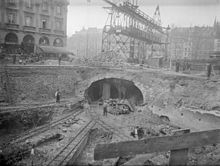
Cut-and-coveris a simple method of construction for shallow tunnels where atrenchis excavated androofedover with an overhead support system strong enough to carry the load of what is to be built above the tunnel.[21]
There are two basic forms of cut-and-cover tunnelling:
- Bottom-up method:A trench is excavated, with ground support as necessary, and the tunnel is constructed in it. The tunnel may be of in situ concrete, precast concrete, precast arches, or corrugated steel arches; in early days brickwork was used. The trench is then carefully back-filled and the surface is reinstated.
- Top-down method:Side support walls and capping beams are constructed from ground level by such methods asslurry wallingor contiguous bored piling. Only a shallow excavation is needed to construct the tunnel roof using precast beams or in situ concrete sitting on the walls. The surface is then reinstated except for access openings. This allows early reinstatement of roadways, services, and other surface features. Excavation then takes place under the permanent tunnel roof, and the base slab is constructed.
Shallow tunnels are often of the cut-and-cover type (if under water, of the immersed-tube type), while deep tunnels are excavated, often using atunnelling shield.For intermediate levels, both methods are possible.
Large cut-and-cover boxes are often used for undergroundmetrostations, such asCanary Wharf tube stationin London. This construction form generally has two levels, which allows economical arrangements for ticket hall, station platforms, passenger access and emergency egress, ventilation and smoke control, staff rooms, and equipment rooms. The interior of Canary Wharf station has been likened to an underground cathedral, owing to the sheer size of the excavation. This contrasts with many traditional stations onLondon Underground,where bored tunnels were used for stations and passenger access. Nevertheless, the original parts of the London Underground network, the Metropolitan and District Railways, were constructed using cut-and-cover. These lines pre-dated electric traction and the proximity to the surface was useful to ventilate the inevitable smoke and steam.
A major disadvantage of cut-and-cover is the widespread disruption generated at the surface level during construction.[22]This, and the availability of electric traction, brought about London Underground's switch to bored tunnels at a deeper level towards the end of the 19th century.
Prior to the replacement of manual excavation by the use of boring machines,Victoriantunnel excavators developed a specialized method called clay-kicking for digging tunnels in clay-based soils. The clay-kicker lies on a plank at a 45-degree angle away from the working face and rather than amattockwith his hands, inserts with his feet a tool with a cup-like rounded end, then turns the tool with his hands to extract a section of soil, which is then placed on the waste extract. Clay-kicking is a specialized method developed in theUnited Kingdomof digging tunnels in strong clay-based soil structures. This method of cut and cover construction required relatively little disturbance of property during the renewal of the United Kingdom's then ancientseweragesystems. It was also used during theFirst World WarbyRoyal Engineer tunnelling companiesplacing mines beneathGermanlines, because it was almost silent and so not susceptible to listening methods of detection.[23]
Boring machines
[edit]
Tunnel boring machines(TBMs) and associated back-up systems are used to highly automate the entire tunnelling process, reducing tunnelling costs. In certain predominantly urban applications, tunnel boring is viewed as a quick and cost-effective alternative to laying surface rails and roads. Expensivecompulsory purchaseof buildings and land, with potentially lengthy planning inquiries, is eliminated. Disadvantages of TBMs arise from their usually large size – the difficulty of transporting the large TBM to the site of tunnel construction, or (alternatively) the high cost of assembling the TBM on-site, often within the confines of the tunnel being constructed.
There are a variety of TBM designs that can operate in a variety of conditions, from hard rock to soft water-bearing ground. Some TBMs, the bentonite slurry and earth-pressure balance types, have pressurized compartments at the front end, allowing them to be used in difficult conditions below thewater table.This pressurizes the ground ahead of the TBM cutter head to balance the water pressure. The operators work in normal air pressure behind the pressurized compartment, but may occasionally have to enter that compartment to renew or repair the cutters. This requires special precautions, such as local ground treatment or halting the TBM at a position free from water. Despite these difficulties, TBMs are now preferred over the older method of tunnelling in compressed air, with an airlock/decompression chamber some way back from the TBM, which required operators towork in high pressureand go through decompression procedures at the end of their shifts, much likedeep-sea divers.
In February 2010, Aker Wirth delivered a TBM to Switzerland, for the expansion of theLinth–Limmern Power Stationslocated south ofLinthalin thecanton of Glarus.The borehole has a diameter of 8.03 metres (26.3 ft).[24]The four TBMs used for excavating the 57-kilometre (35 mi)Gotthard Base Tunnel,inSwitzerland,had a diameter of about 9 metres (30 ft). A larger TBM was built to bore the Green Heart Tunnel (Dutch: Tunnel Groene Hart) as part of theHSL-Zuidin the Netherlands, with a diameter of 14.87 metres (48.8 ft).[25]This in turn was superseded by theMadrid M30 ringroad,Spain, and theChong Mingtunnels inShanghai,China. All of these machines were built at least partly byHerrenknecht.As of August 2013[update],the world's largest TBM was "Big Bertha",a 17.5-metre (57.5 ft) diameter machine built byHitachi Zosen Corporation,which dug theAlaskan Way Viaduct replacement tunnelinSeattle, Washington(US).[26]
Shafts
[edit]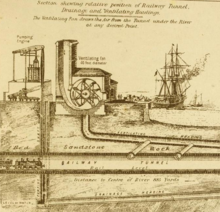
A temporary accessshaftis sometimes necessary during the excavation of a tunnel. They are usually circular and go straight down until they reach the level at which the tunnel is going to be built. A shaft normally has concrete walls and is usually built to be permanent. Once the access shafts are complete, TBMs are lowered to the bottom and excavation can start. Shafts are the main entrance in and out of the tunnel until the project is completed. If a tunnel is going to be long, multiple shafts at various locations may be bored so that entrance to the tunnel is closer to the unexcavated area.[14]
Once construction is complete, construction access shafts are often used asventilation shafts,and may also be used as emergency exits.
Sprayed concrete techniques
[edit]TheNew Austrian Tunnelling method(NATM)—also referred to as the Sequential Excavation Method (SEM)[27]—was developed in the 1960s. The main idea of this method is to use the geologicalstressof the surroundingrockmassto stabilize the tunnel, by allowing a measured relaxation and stress reassignment into the surrounding rock to prevent full loads becoming imposed on the supports. Based ongeotechnicalmeasurements, an optimalcross sectionis computed. The excavation is protected by a layer of sprayed concrete, commonly referred to asshotcrete.Other support measures can include steel arches, rock bolts, and mesh. Technological developments in sprayed concrete technology have resulted in steel and polypropylene fibers being added to the concrete mix to improve lining strength. This creates a natural load-bearing ring, which minimizes the rock'sdeformation.[27]
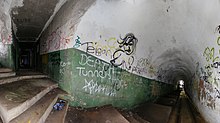
By specialmonitoringthe NATM method is flexible, even at surprising changes of thegeomechanicalrock consistency during the tunneling work. The measured rock properties lead to appropriatetoolsfor tunnelstrengthening.[27]
Pipe jacking
[edit]Inpipe jacking,hydraulic jacksare used to push specially made pipes through the ground behind a TBM or shield. This method is commonly used to create tunnels under existing structures, such as roads or railways. Tunnels constructed by pipe jacking are normally small diameter bores with a maximum size of around 3.2 metres (10 ft).
Box jacking
[edit]Box jacking is similar to pipe jacking, but instead of jacking tubes, a box-shaped tunnel is used. Jacked boxes can be a much larger span than a pipe jack, with the span of some box jacks in excess of 20 metres (66 ft). A cutting head is normally used at the front of the box being jacked, and spoil removal is normally by excavator from within the box. Recent developments of the Jacked Arch and Jacked deck have enabled longer and larger structures to be installed to close accuracy.
Underwater tunnels
[edit]
There are also several approaches to underwater tunnels, the two most common being bored tunnels orimmersed tubes,examples areBjørvika TunnelandMarmaray.Submerged floating tunnelsare a novel approach under consideration; however, no such tunnels have been constructed to date.
Temporary way
[edit]During construction of a tunnel it is often convenient to install a temporary railway, particularly to removeexcavated spoil,oftennarrow gaugeso that it can bedouble trackto allow the operation of empty and loaded trains at the same time. The temporary way is replaced by thepermanent wayat completion, thus explaining the term "Perway".
Enlargement
[edit]
The vehicles or traffic using a tunnel can outgrow it, requiring replacement or enlargement:
- The original single lineGib TunnelnearMittagongwas replaced with a double-track tunnel, with the original tunnel used for growing mushrooms.[28][29]
- The 1832 double-track 1.6-kilometre (1 mi)-long tunnel fromEdge HilltoLime StreetinLiverpoolwas near totally removed, apart from a 50-metre (55 yd) section at Edge Hill and a section nearer to Lime Street, as four tracks were required. The tunnel was dug out into a very deep four-track cutting, with short tunnels in places along the cutting. Train services were not interrupted as the work progressed.[30][31]There are other occurrences of tunnels being replaced by open cuts, for example, theAuburn Tunnel.
- TheFarnworth Tunnelin England was enlarged using atunnel boring machine(TBM) in 2015.[32]TheRhyndaston Tunnelwas enlarged using a borrowed TBM so as to be able to takeISO containers.
- Tunnels can also be enlarged by lowering the floor.[33]
Open building pit
[edit]An open building pit consists of a horizontal and a vertical boundary that keeps groundwater and soil out of the pit. There are several potential alternatives and combinations for (horizontal and vertical) building pit boundaries. The most important difference with cut-and-cover is that the open building pit is muted after tunnel construction; no roof is placed.
Other construction methods
[edit]
- Drilling and blasting
- Hydraulic splitter
- Slurry-shield machine
- Wall-cover construction method.
Variant tunnel types
[edit]Double-deck and multipurpose tunnels
[edit]
Some tunnels are double-deck, for example, the two major segments of theSan Francisco–Oakland Bay Bridge(completed in 1936) are linked by a 160-metre (540 ft)double-deck tunnelsection throughYerba Buena Island,the largest-diameter bored tunnel in the world.[34]At construction this was a combination bidirectional rail and truck pathway on the lower deck with automobiles above, now converted to one-way road vehicle traffic on each deck.
In Turkey, theEurasia Tunnelunder theBosphorus,opened in 2016, has at its core a 5.4 km (3.4 miles) two-deck road tunnel with two lanes on each deck.[35]
Additionally, in 2015 the Turkish government announced that it will buildthree-level tunnel, also under the Bosporus.[36]The tunnel is intended to carry both the Istanbul metro and a two-level highway, over a length of 6.5 km (4.0 miles).
The FrenchA86 Duplex Tunnelin west Paris consists of two bored tunnel tubes, the eastern one of which has two levels for light motorized vehicles, over a length of 10 km (6.2 miles). Although each level offers a physical height of 2.54 m (8.3 ft), only traffic up to 2 m (6.6 ft) tall is allowed in this tunnel tube, and motorcyclists are directed to the other tube. Each level was built with a three-lane roadway, but only two lanes per level are used – the third serves as a hard shoulder within the tunnel. The A86 Duplex is Europe's longest double-deck tunnel.
InShanghai,China, a 2.8 km (1.7 miles) two-tube double-deck tunnel was built starting in 2002. In each tube of theFu xing Road Tunnelboth decks are for motor vehicles. In each direction, only cars and taxis travel on the 2.6 m (8.5 ft) high two-lane upper deck, and heavier vehicles, like trucks and buses, as well as cars, may use the 4.0 m (13 ft) high single-lane lower level.[37]
In the Netherlands, a 2.3 km (1.4 miles) two-storey, eight-lane, cut-and-cover road tunnel under the city ofMaastrichtwas opened in 2016.[38]Each level accommodates a full height, two by two-lane highway. The two lower tubes of the tunnel carry theA2 motorway,which originates in Amsterdam, through the city; and the two upper tubes take the N2 regional highway for local traffic.[39]
TheAlaskan Way Viaduct replacement tunnel,is a $3.3 billion 2.83-kilometre (1.76 mi), double-decker bored highway tunnel underDowntown Seattle.Construction began in July 2013 using "Bertha",at the time the world's largestearth pressure balancetunnel boring machine, with a 17.5-metre (57.5 ft) cutterhead diameter. After several delays, tunnel boring was completed in April 2017, and the tunnel opened to traffic on 4 February 2019.
New York City's63rd Street Tunnelunder theEast River,between the boroughs ofManhattanandQueens,was intended to carrysubwaytrains on the upper level andLong Island Rail Roadcommuter trains on the lower level. Construction started in 1969,[40]and the two sides of the tunnel were bored through in 1972.[41]The upper level, used by theIND 63rd Street Line(Fand<F>train) of the New York City Subway, was not opened for passenger service until 1989.[42]The lower level, intended for commuter rail, saw passenger service after completion of theEast Side Accessproject, in late 2022.[43]
In the UK, the 1934Queensway Tunnelunder theRiver MerseybetweenLiverpoolandBirkenheadwas originally to have road vehicles running on the upper deck and trams on the lower. During construction the tram usage was cancelled. The lower section is only used for cables, pipes and emergency accident refuge enclosures.
Hong Kong'sLion Rock Tunnel,built in the mid 1960s, connectingNew KowloonandSha Tin,carries a motorway but also serves as anaqueduct,featuring a gallery containing five water mains lines with diameters between 1.2 and 1.5 m (4 and 5 ft) below the road section of the tunnel.[44]
Wuhan's Yangtze River Highway and Railway Tunnel is a 2.59 km (1.61 mi) two-tube double-deck tunnel under theYangtze Rivercompleted in 2018. Each tube carries three lanes of local traffic on the top deck with one trackWuhan MetroLine 7on the lower deck.[45][46][47]
Mount Baker Tunnelhas three levels. The bottom level is to be used bySound Transitlight rail. The middle level is used by car traffic, and the top layer is for bicycle and pedestrian access.
Some tunnels have more than one purpose. TheSMART TunnelinMalaysiais the first multipurpose "Stormwater Management And Road Tunnel"in the world, created to convey both traffic and occasionalfloodwaters inKuala Lumpur.When necessary, floodwater is first diverted into a separate bypass tunnel locatedunderneaththe 4.0 km (2.5 miles) double-deck roadway tunnel. In this scenario, traffic continues normally. Only during heavy, prolonged rains when the threat of extreme flooding is high, the upper tunnel tube is closed off to vehicles and automated flood control gates are opened so that water can be diverted through both tunnels.[48]
Common utility ductsor utility tunnels carry two or more utility lines. Through co-location of different utilities in one tunnel, organizations are able to reduce the costs of building and maintaining utilities.
Covered passageways
[edit]
Over-bridges can sometimes be built by covering a road or river or railway withbrickorsteelarches,and then leveling the surface with earth. In railway parlance, a surface-level track which has been built or covered over is normally called a "covered way".
Snow shedsare a kind of artificial tunnel built to protect a railway fromavalanchesof snow. Similarly theStanwell Park,New South Wales"steel tunnel", on theIllawarra railway line,protects the line from rockfalls.
Underpass
[edit]
Anunderpassis a road or railway or other passageway passingunderanother road or railway, under anoverpass.This is not strictly a tunnel.
Safety and security
[edit]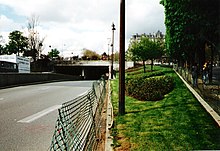
Owing to the enclosed space of a tunnel, fires can have very serious effects on users. The main dangers are gas and smoke production, with even low concentrations ofcarbon monoxidebeing highly toxic. Fires killed 11 people in theGotthard tunnel fireof 2001 for example, all of the victims succumbing to smoke and gas inhalation. Over 400 passengers died in theBalvano train disasterin Italy in 1944, when the locomotive halted in a long tunnel.Carbon monoxide poisoningwas the main cause of death. In theCaldecott Tunnel fireof 1982, the majority of fatalities were caused by toxic smoke, rather than by the initial crash. Likewise 84 people were killed in theParis Métro train fireof 1904.
Motor vehicle tunnels usually requireventilation shaftsand powered fans to remove toxicexhaust gasesduring routine operation.[49]
Rail tunnels usually require fewerair changes per hour,but still may requireforced-air ventilation.Both types of tunnels often have provisions to increase ventilation under emergency conditions, such as a fire. Although there is a risk of increasing therate of combustionthrough increased airflow, the primary focus is on providing breathable air to persons trapped in the tunnel, as well asfirefighters.
Theaerodynamicpressure waveproduced byhigh speed trainsentering a tunnel[50]reflect at its open ends and change sign (compressionwavefront changes torarefactionwavefront and vice versa). When two wavefronts of the same sign meet the train, significant and rapid air pressure[51]may cause ear discomfort[52]for passengers and crew. When a high-speed train exits a tunnel, a loud "Tunnel boom"may occur, which can disturb residents near the mouth of the tunnel, and it is exacerbated in mountain valleys where the sound can echo.
When there is a parallel, separate tunnel available, airtight but unlocked emergency doors are usually provided which allow trapped personnel to escape from a smoke-filled tunnel to the parallel tube.[53]
Larger, heavily used tunnels, such as theBig Digtunnel inBoston, Massachusetts,may have a dedicated 24-hour staffedoperations centerwhich monitors and reports on traffic conditions, and responds to emergencies.[54]Video surveillanceequipment is often used, and real-time pictures of traffic conditions for some highways may be viewable by the general public via the Internet.
A database of seismic damage to underground structures using 217 case histories shows the following general observations can be made regarding the seismic performance of underground structures:
- Underground structures suffer appreciably less damage than surface structures.
- Reported damage decreases with increasing over burden depth. Deep tunnels seem to be safer and less vulnerable to earthquake shaking than are shallow tunnels.
- Underground facilities constructed in soils can be expected to suffer more damage compared to openings constructed in competent rock.
- Lined and grouted tunnels are safer than unlined tunnels in rock. Shaking damage can be reduced by stabilizing the ground around the tunnel and by improving the contact between the lining and the surrounding ground through grouting.
- Tunnels are more stable under a symmetric load, which improves ground-lining interaction. Improving the tunnel lining by placing thicker and stiffer sections without stabilizing surrounding poor ground may result in excess seismic forces in the lining. Backfilling with non-cyclically mobile material[clarification needed]and rock-stabilizing measures may improve the safety and stability of shallow tunnels.
- Damage may be related to peak ground acceleration and velocity based on the magnitude and epicentral distance of the affected earthquake.
- Duration of strong-motion shaking during earthquakes is of utmost importance because it may cause fatigue failure and therefore, large deformations.
- High frequency motions may explain the local spalling of rock or concrete along planes of weakness. These frequencies, which rapidly attenuate with distance, may be expected mainly at small distances from the causative fault.
- Ground motionmay be amplified upon incidence with a tunnel if wavelengths are between one and four times the tunnel diameter.
- Damage at and near tunnel portals may be significant due to slope instability.[55]
Earthquakes are one of nature's most formidable threats. A magnitude 6.7 earthquake shook the San Fernando valley in Los Angeles in 1994. The earthquake caused extensive damage to various structures, including buildings, freeway overpasses and road systems throughout the area. The National Center for Environmental Information estimates total damages to be 40 billion dollars.[56]According to an article issued by Steve Hymon of TheSource – Transportation News and Views, there was no serious damage sustained by the LA subway system. Metro, the owner of the LA subway system, issued a statement through their engineering staff about the design and consideration that goes into a tunnel system. Engineers and architects perform extensive analysis as to how hard they expect earthquakes to hit that area. All of this goes into the overall design and flexibility of the tunnel.
This same trend of limited subway damage following an earthquake can be seen in many other places. In 1985 a magnitude 8.1 earthquake shook Mexico City; there was no damage to the subway system, and in fact the subway systems served as a lifeline for emergency personnel and evacuations. A magnitude 7.2 ripped through Kobe Japan in 1995, leaving no damage to the tunnels themselves. Entry portals sustained minor damages, however these damages were attributed to inadequate earthquake design that originated from the original construction date of 1965. In 2010 a magnitude 8.8, massive by any scale, afflicted Chile. Entrance stations to subway systems suffered minor damages, and the subway system was down for the rest of the day. By the next afternoon, the subway system was operational again.[57]
Examples
[edit]This section mayrequirecleanupto meet Wikipedia'squality standards.The specific problem is:just a random list.(December 2017) |
In history
[edit]This sectionneeds additional citations forverification.(March 2013) |





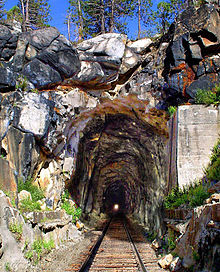


The history of ancient tunnels and tunneling in the world is reviewed in various sources which include many examples of these structures that were built for different purposes.[58][59]Some well known ancient and modern tunnels are briefly introduced below:
- TheqanatorkareezofPersiaare water management systems used to provide a reliable supply of water to human settlements or for irrigation in hot, arid and semi-arid climates. The deepest known qanat is in the Iranian city ofGonabad,which after 2700 years, still provides drinking and agricultural water to nearly 40,000 people. Its main well depth is more than 360 m (1,180 ft), and its length is 45 km (28 mi).[60]
- TheSiloam Tunnelwas built before 701 BC for a reliable supply of water, to withstandsiegeattacks.
- TheEupalinian aqueducton the island ofSamos(North Aegean,Greece) was built in 520 BC by the ancient Greek engineerEupalinosofMegaraunder a contract with the local community. Eupalinos organised the work so that the tunnel was begun from both sides of Mount Kastro. The two teams advanced simultaneously and met in the middle with excellent accuracy, something that was extremely difficult in that time. The aqueduct was of utmost defensive importance, since it ran underground, and it was not easily found by an enemy who could otherwise cut off the water supply toPythagoreion,the ancient capital ofSamos.The tunnel's existence was recorded by Herodotus (as was the mole and harbour, and the third wonder of the island, the great temple to Hera, thought by many to be the largest in the Greek world). The precise location of the tunnel was only re-established in the 19th century by German archaeologists. The tunnel proper is 1,030 m long (3,380 ft) and visitors can still enter it.
- One of the first known drainage and sewage networks in form oftunnelswas constructed at Persepolis in Iran at the same time as the construction of its foundation in 518 BC. In most places the network was dug in the sound rock of the mountain and then covered by large pieces of rock and stone followed by earth and piles of rubble to level the ground. During investigations and surveys, long sections of similar rock tunnels extending beneath the palace area were traced by Herzfeld and later by Schmidt and their archeological teams.[61]
- TheVia Flaminia,an importantRoman road,penetrated theFurlopass in theApenninesthrough a tunnel which emperorVespasianhad ordered built in 76–77 AD. A modern road, the SS 3 Flaminia, still uses this tunnel, which had a precursor dating back to the 3rd century BC, remnants of this earlier tunnel (one of the first road tunnels) are also still visible.
- The world's oldest tunnel traversing under a water body is claimed[62]to be theTerelek kaya tüneliunderKızıl River,a little south of the towns ofBoyabatandDurağaninTurkey,just downstream from whereKizil Riverjoins its tributaryGökırmak.The tunnel is presently under a narrow part of a lake formed by a dam some kilometers further downstream. Estimated to have been built more than 2000 years ago, possibly by the same civilization that also built the royal tombs in a rock face nearby, it is assumed to have had a defensive purpose.
- Sapperton Canal Tunnelon theThames and Severn CanalinEngland,dug through hills, which opened in 1789, was 3.5 km (2.2 mi) long and allowedboattransport ofcoaland other goods. Above it theSapperton Long Tunnelwas constructed which carries the "Golden Valley" railway line betweenSwindonandGloucester.
- The 1791Dudley canal tunnelis on theDudley Canal,inDudley,England.The tunnel is 2.9 kilometres (1.83 mi) long. Closed in 1962 the tunnel was reopened in 1973. The series of tunnels was extended in 1984 and 1989.[63]
- Fritchley Tunnel,constructed in 1793 in Derbyshire by theButterley Companyto transport limestone to its ironworks factory. The Butterley company engineered and built its own railway. A victim of the depression the company closed after 219 years in 2009. The tunnel is the world's oldest railway tunnel traversed by rail wagons. Gravity and horse haulage was utilised. The railway was converted to steam locomotion in 1813 using aSteam Horse locomotiveengineered and built by the Butterley company, however reverted to horses. Steam trains used the tunnel continuously from the 1840s when the railway was converted to a narrow gauge. The line closed in 1933. In the Second World War, the tunnel was used as an air raid shelter. Sealed up in 1977 it was rediscovered in 2013 and inspected. The tunnel was resealed to preserved the construction as it was designated an ancient monument.[64][65]
- The 1794Butterley canal tunnelcanal tunnel is 2,819 m (1.8 mi) in length on theCromford CanalinRipley, Derbyshire,England. The tunnel was built simultaneously with the 1793 Fritchley railway tunnel. The tunnel partially collapsed in 1900 splitting the Cromford Canal, and has not been used since. The Friends of Cromford Canal, a group of volunteers, are working at fully restoring the Cromford Canal and the Butterley Tunnel.[66]
- The 1796 Stoddart Tunnel in Chapel-en-le-Frith inDerbyshireis reputed to be the oldest rail tunnel in the world. The rail wagons were originally horse-drawn.
- Derby TunnelsinSalem, Massachusetts,were built in 1801 to smuggle imports affected by PresidentThomas Jefferson's new customs duties. Jefferson had ordered local militias to help the Custom House in each port collect these dues, but the smugglers, led by Elias Derby, hired the Salem militia to dig the tunnels and hide the spoil.
- A tunnel was created for the first true steam locomotive, fromPenydarrentoAbercynon.The Penydarren locomotive was built byRichard Trevithick.The locomotive made the historic journey from Penydarren to Abercynon in 1804. Part of this tunnel can still be seen atPentrebach,Merthyr Tydfil,Wales.This is arguably the oldest railway tunnel in the world, dedicated only to self-propelled steam engines on rails.
- TheMontgomery Bell Tunnelin Tennessee, an 88 m long (289 ft) water diversion tunnel, 4.50 m × 2.45 m high (14.8 ft × 8.0 ft), to power a water wheel, was built by slave labour in 1819, being the first full-scale tunnel in North America.
- Bourne's Tunnel,Rainhill,nearLiverpool,England. It is 32.1 m (105 ft) long. Built in the late 1820s, the exact date is unknown, however probably built in 1828 or 1829. This is the first tunnel in the world constructed under a railway line. The construction of the Liverpool to Manchester Railway ran over a horse-drawn tramway that ran from the Sutton collieries to the Liverpool-Warrington turnpike road. A tunnel was bored under the railway for the tramway. As the railway was being constructed the tunnel was made operational, opening prior to the Liverpool tunnels on the Liverpool to Manchester line. The tunnel was made redundant in 1844 when the tramway was dismantled.[67]
- Crown Street station,Liverpool,England, 1829. Built byGeorge Stephenson,a single track railway tunnel 266 m long (873 ft), was bored from Edge Hill to Crown Street to serve the world's first intercity passenger railway terminus station. The station was abandoned in 1836 being too far from Liverpool city centre, with the area converted for freight use. Closed down in 1972, the tunnel is disused. However it is the oldest passenger rail tunnel running under streets in the world.[68][69]
- The 1829Wapping Tunnelin Liverpool, England, at 2.03 km (1.26 mi) long on a twin track railway, was the first rail tunnel bored under a metropolis. The tunnel's path is from Edge Hill in the east of the city toWapping Dockin the south end Liverpool docks. The tunnel was used only for freight terminating at thePark Lane goods terminal.Currently disused since 1972, the tunnel was to be a part of theMerseyrailmetro network, with work started and abandoned because of costs. The tunnel is in excellent condition and is still being considered for reuse by Merseyrail, maybe with an underground station cut into the tunnel for Liverpool university. The river portal is opposite the newKing's Dock Liverpool Arenabeing an ideal location for a serving station. If reused the tunnel will be the oldest used underground rail tunnel in the world and oldest section of any underground metro system.[69][70][71]
- 1832,Lime Street railway stationtunnel, Liverpool. A two track rail tunnel, 1.811 km (1.125 mi) long was bored under the metropolis from Edge Hill in the east of the city to Lime Street in Liverpool's city centre. The tunnel was in use from 1832 being used to transport building materials to the new Lime St station while under construction. The station and tunnel was opened to passengers in 1836. In the 1880s the tunnel was converted to a deep cutting, open to the atmosphere, being four tracks wide. This is the only occurrence of a major tunnel being removed. Two short sections of the original tunnel still exist at Edge Hill station and further towards Lime Street, giving the two tunnels the distinction of being the oldest rail tunnels in the world still in use, and the oldest in use under streets.[72]Over time a 525 m (0.326 mi) section of the deep cutting has been converted back into tunnel due to sections having buildings built over.
- Box Tunnelin England, which opened in 1841, was the longest railway tunnel in the world at the time of construction. It was dug by hand, and has a length of 2.9 km (1.8 mi).
- The 1.1 km (0.68 mi) 1842 Prince of Wales Tunnel, inShildonnear Darlington, England, is the oldest sizeable tunnel in the world still in use under a settlement.
- TheVictoria Tunnel Newcastleopened in 1842, is a 3.9-kilometre (2.4 mi) subterranean wagonway with a maximum depth of 26 metres (85 ft) that drops 222 feet (68 m) from entrance to exit. The tunnel runs under Newcastle upon Tyne, England, and originally exited at the River Tyne. It remains largely intact. Originally designed to carry coal fromSpital Tonguesto the river, in WW2 part of the tunnel was used as a shelter. Under the management of a charitable foundation called the Ouseburn Trust it is currently used for heritage tours.
- TheThames Tunnel,built byMarc Isambard Bruneland his sonIsambard Kingdom Brunelopened in 1843, was the first tunnel (after Terelek) traversing under a water body, and the first to be built using atunnelling shield.Originally used as a foot-tunnel, the tunnel was converted to a railway tunnel in 1869 and was a part of theEast London Lineof theLondon Undergrounduntil 2007. It was the oldest section of the network, although not the oldest purpose built rail section. From 2010 the tunnel became a part of theLondon Overgroundnetwork.
- The 3.34 km (2.08 mi)Victoria Tunnel/Waterloo TunnelinLiverpool,England, was bored under a metropolis opening in 1848. The tunnel was initially used only for rail freight serving the Waterloo Freight terminal, and later freight and passengers serving theLiverpool ship liner terminal.The tunnel's path is from Edge Hill in the east of the city to the north end Liverpool docks atWaterloo Dock.The tunnel is split into two tunnels with a short open air cutting linking the two. The cutting is where the cable hauled trains from Edge Hill were hitched and unhitched. The two tunnels are effectively one on the same centre line and are regarded as one. However, as initially the 2,375 m (1.476 mi) long Victoria section was originally cable hauled and the shorter 862 m (943 yd) Waterloo section was locomotive hauled, two separate names were given, the short section was named theWaterloo Tunnel.In 1895 the two tunnels were converted to locomotive haulage. Used until 1972, the tunnel is still in excellent condition. A short section of the Victoria tunnel at Edge Hill is still used for shunting trains. The tunnel is being considered for reuse by theMerseyrailnetwork. Stations cut into the tunnel are being considered and also reuse by a monorail system from the proposedLiverpool Watersredevelopment of Liverpool's Central Docks has been proposed.[73][74]
- The summit tunnel of theSemmering railway,the first Alpine tunnel, was opened in 1848 and was 1.431 km (0.889 mi) long. It connected rail traffic betweenVienna,the capital ofAustro-Hungarian Empire,andTrieste,its port.
- TheGiovi Rail Tunnelthrough theAppenniniMounts opened in 1854, linking the capital city of theKingdom of Sardinia,Turin,to its port,Genoa.The tunnel was 3.25 km (2.02 mi) long.
- The oldest underground sections of theLondon Undergroundwere built using the cut-and-cover method in the 1860s, and opened in January 1863. What are now theMetropolitan,Hammersmith & City and Circle lines were the first to prove the success of ametroor subway system.
- On 18 June 1868, theCentral Pacific Railroad's 506-metre (1,659 ft) Summit Tunnel (Tunnel #6) atDonner Passin the CaliforniaSierra Nevadamountains was opened, permitting the establishment of the commercial mass transportation of passengers and freight over the Sierras for the first time. It remained in daily use until 1993, when theSouthern Pacific Railroadclosed it and transferred all rail traffic through the 3,146-metre (10,322 ft) long Tunnel #41 (a.k.a. "The Big Hole" ) built a mile to the south in 1925.
- In 1870, after fourteen years of works, theFréjus Rail Tunnelwas completed between France and Italy, being the second-oldest Alpine tunnel, 13.7 km (8.5 mi) long. At that time it was the longest in the world.
- The third Alpine tunnel, theGotthard Rail Tunnel,between northern and southern Switzerland, opened in 1882 and was the longest rail tunnel in the world, measuring 15 km (9.3 mi).
- The 1882Col de Tende Road Tunnel,at 3.182 km (1.977 mi) long, was one of the first long road tunnels under a pass, running between France and Italy.
- TheMersey Railwaytunnel opened in 1886, running from Liverpool to Birkenhead under the River Mersey. TheMersey Railwaywas the world's first deep-level underground railway. By 1892 the extensions on land from Birkenhead Park station to Liverpool Central Low level station gave a tunnel 5.02 km (3.12 mi) in length. The under river section is 1.21 km (0.75 mi) in length, and was the longest underwater tunnel in world in January 1886.[75][76]
- The railSevern Tunnelwas opened in late 1886, at 7.008 km (4.355 mi) long, although only 3.62 km (2.25 mi) of the tunnel is actually under the River Severn. The tunnel replaced the Mersey Railway tunnel's longest under water record, which was held for less than a year.
- James Greathead,in constructing the City & South London Railway tunnel beneath the Thames, opened in 1890, brought together three key elements of tunnel construction under water:
- shield method of excavation;
- permanent cast iron tunnel lining;
- construction in a compressed air environment to inhibit water flowing through soft ground material into the tunnel heading.[77]
- Built in sections between 1890 and 1939, the section of London Underground'sNorthern linefrom Morden to East Finchley via Bank was the longest railway tunnel in the world at 27.8 km (17.3 mi) in length.
- St. Clair Tunnel,also opened later in 1890, linked the elements of the Greathead tunnels on a larger scale.[77]
- In 1906 the fourth Alpine tunnel opened, theSimplon Tunnel,between Switzerland and Italy. It is 19.8 km (12.3 mi) long, and was the longest tunnel in the world until 1982. It was also the deepest tunnel in the world, with a maximum rock overlay of approximately 2,150 m (7,050 ft).
- The 1927Holland Tunnelwas the first underwater tunnel designed for automobiles. The construction required a novelventilation system.
- In 1945 theDelaware Aqueducttunnel was completed, supplying water to New York City. At 137 km (85 mi) it is the longest tunnel in the world.
- In 1988 the 53.850 km (33.461 mi) longSeikan Tunnelin Japan was completed under theTsugaru Strait,linking the islands ofHonshuandHokkaido.It was the longest railway tunnel in the world at that time.
- Ryfastis the longest undersea road tunnel. It is 14.3 km (8.9 mi) in length.[78]The tunnel opened for use in 2020.
Longest
[edit]
- TheThirlmere AqueductinNorth West England,United Kingdom is sometimes considered the longest tunnel, of any type, in the world at 154 km (96 mi), though the aqueduct's tunnel section is not continuous.[dubious–discuss]
- TheDahuofang Water TunnelinChina,opened in 2009, is the third longest water tunnel in the world at 85.3 km (53.0 mi) length.
- TheGotthard Base TunnelinSwitzerland,opened in 2016, is the longest and deepest railway tunnel in the world at 57.1 km (35.5 mi) length and 2,450 m (8,040 ft) maximum depth below theGotthard Massif.It provides aflat transit routebetween the North and South of Europe under theSwiss Alps,at a maximum elevation of 549 m (1,801 ft).
- TheSeikan TunnelinJapanconnects the main island ofHonshuwith the northern island ofHokkaidoby rail. It is 53.9-kilometre (33.5 mi) long, of which 23.3 km (14.5 mi) are crossing theTsugaru Straitundersea.
- TheChannel Tunnelcrosses theEnglish ChannelbetweenFranceand theUnited Kingdom.It has a total length of 50 km (31 mi), of which 39 km (24 mi) are the world's longest undersea tunnel section.
- TheLötschberg Base TunnelinSwitzerlandwas the longest land rail tunnel, with a length of 34.5 km (21.4 mi), from its inauguration in 2007 until the completion of theGotthard Base Tunnelin 2016.
- TheLærdal Tunnelin Norway fromLærdaltoAurlandis the world's longest road tunnel, intended for cars and similar vehicles, at 24.5 km (15.2 mi).
- TheZhongnanshan TunnelinPeople's Republic of Chinaopened in January 2007 is the world's second longesthighwaytunnel and the longest mountain road tunnel in Asia, at 18 km (11 mi).
- The longest canal tunnel is theRove Tunnelin France, over 7.12 km (4.42 mi) long.
Notable
[edit]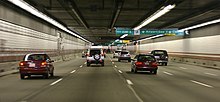


- TheMoffat Tunnel,opened in 1928, passes under theContinental Divide of the AmericasinColorado.The tunnel is 10.0 km (6.2 mi) long and at an elevation of 2,816 m (9,239 ft) is the highest active railroad tunnel in the U.S. (The inactiveTennessee Pass Lineand the historicAlpine Tunnelare higher.)
- Williamson's tunnelsinLiverpool,from 1804 and completed around 1840 by a wealthy eccentric, are probably the largest undergroundfollyin the world. The tunnels were built with no functional purpose.
- TheChicago freight tunnel networkis the largest urban street tunnel network, comprising 97 km (60 mi) of tunnels beneath the majority of downtownChicagostreets. It operated between 1906 and 1956 as a freight network, connecting building basements and railway stations. Following a1992 floodthe network was sealed, although some parts still carry utility and communications infrastructure.
- ThePennsylvania Turnpikeopened in 1940 with seven tunnels, most of which were bored as part of the stillbornSouth Pennsylvania Railroadand giving the highway the nickname "Tunnel Highway". Four of the tunnels (Allegheny Mountain,Tuscarora Mountain,Kittatinny Mountain,andBlue Mountain) remain in active use, while the other three (Laurel Hill,Rays Hill,andSideling Hill) were bypassed in the 1960s; the latter two tunnels are on a bypassed section of the Turnpike now commonly known as theAbandoned Pennsylvania Turnpike.
- TheFredhälls road tunnelwas opened in 1966, inStockholm, Sweden,and theNew Elbe road tunnelopened in 1975 inHamburg, Germany.Both tunnels handle around 150,000 vehicles a day, making them two of the most trafficked tunnels in the world.
- TheHonningsvåg Tunnel(4.443 km (2.76 mi) long) opened in 1999 onEuropean route E69in Norway as the world's northernmost road tunnel, except for mines (which exist onSvalbard).
- The Central Artery road tunnel inBoston, Massachusetts,is a part of the largerBig Digcompleted around 2007, and carries approximately 200,000 vehicles/day under the city alongInterstate 93,US Route 1,andMassachusetts Route 3,which share aconcurrencythrough the tunnels. The Big Dig replaced Boston's old badly deteriorated I-93 elevated highway.
- The Stormwater Management And Road Tunnel orSMART Tunnel,is a combined storm drainage and road structure opened in 2007 inKuala Lumpur,Malaysia. The 9.7 km (6.0 mi) tunnel is the longest stormwaterdrainage tunnelin South East Asia and second longest in Asia. The facility can be operated as a simultaneous traffic and stormwater passage, or dedicated exclusively to stormwater when necessary.
- TheEiksund Tunnel[79]on national road Rv 653 in Norway is the world's deepest subsea road tunnel, measuring 7.776 km (4.832 mi) long, with deepest point at −287 m (−942 ft) below the sea level, opened in February 2008.
- Gerrards Cross railway tunnel,in England, opened in 2010, is notable in that it converted an existing railway cutting into a tunnel to create ground to build a supermarket over the tunnel. The railway in the cutting was first opened around 1906, stretching over 104 years to complete a railway tunnel. The tunnel was built using the cover method with craned in prefabricated forms in order to keep the busy railway operating. A branch of theTescosupermarket chain occupies the newly created ground above the railway tunnel, with an adjacent existing railway station at the end of the tunnel. During construction, a portion of the tunnel collapsed when soil cover was added. The prefabricated forms were covered with a layer of reinforced concrete after the collapse.[80]
- TheFenghuoshan tunnel,completed in 2005 on theQinghai-Tibet railwayis the world's highest railway tunnel, about 4.905 km (3.05 mi) above sea level and 1,338 m (0.831 mi) long.
- TheLa LineaTunnel inColombia,2016, is the longest, 8.58 km (5.33 mi), mountain tunnel in South America. It crosses beneath a mountain at 2,500 m (8,202.1 ft) above sea level with six traffic lanes, and it has a parallel emergency tunnel. The tunnel is subject to seriousgroundwaterpressure. The tunnel will linkBogotáand its urban area with the coffee-growing region, and with the main port on the Colombian Pacific coast.
- TheChicago Deep Tunnel Projectis a network of 175 km (109 mi) ofdrainage tunnelsdesigned to reduce flooding in theChicago area.Started in the mid-1970s, the project is due to be completed in 2029.
- New York City Water Tunnel No. 3,started in 1970, has an expected completion beyond 2026,[81]and will measure more than 97 km long (60 mi).[82]
Mining
[edit]
The use of tunnels for mining is calleddrift mining.Drift mining can help find coal, goal, iron, and other minerals, just like normal mining.
Sub-surface mining consists of digging tunnels or shafts into the earth to reach buried ore deposits.
Military use
[edit]Some tunnels are not for transport at all but rather, are fortifications, for exampleMittelwerkandCheyenne Mountain Complex.Excavation techniques, as well as the construction of underground bunkers and other habitable areas, are often associated withmilitary use during armed conflict,or civilian responses to threat of attack. Another use for tunnels was for the storage of chemical weapons[83][84][1].
Secret tunnels
[edit]
Secret tunnelshave given entrance to or escape from an area, such as theCu Chi Tunnelsor thesmuggling tunnels in the Gaza Stripwhich connect it toEgypt.Although theUnderground Railroadnetwork used to transport escaped slaves was "underground" mostly in the sense of secrecy, hidden tunnels were occasionally used. Secret tunnels were also used during theCold War,under theBerlin Walland elsewhere, to smuggle refugees, and forespionage.
Smugglersuse secret tunnels to transport or storecontraband,such asillegal drugsandweapons.Elaborately engineered 300-metre (1,000 ft) tunnels built to smuggle drugs across the Mexico-US border were estimated to require up to 9 months to complete, and an expenditure of up to $1 million.[85]Some of these tunnels were equipped with lighting, ventilation, telephones, drainage pumps, hydraulic elevators, and in at least one instance, an electrified rail transport system.[85]Secret tunnels have also been used by thieves to break into bank vaults and retail stores after hours.[86][87]Several tunnels have been discovered by theBorder Security Forcesacross theLine of Controlalong theIndia-Pakistan border,mainly to allow terrorists access to the Indian territory ofJammu and Kashmir.[88][89]
The actual usage oferdstalltunnels is unknown but theories connect it to a rebirth ritual.
Natural tunnels
[edit]
- Lava tubesare emptied lava conduits, formed during volcanic eruptions by flowing and cooling lava.
- Natural Tunnel State Park(Virginia, US) features an 260-metre (850 ft) natural tunnel, really a limestonecave,that has been used as a railroad tunnel since 1890.
- Punarjani GuhainKerala, India.Hindus believe that crawling through the tunnel (which they believe was created by a Hindu god) from one end to the other will wash away all of one's sins and thus allow one to attain rebirth. Only men are permitted to crawl through the tunnel.
- Torghatten,a Norwegian island with a hat-shaped silhouette, has a natural tunnel in the middle of the hat, letting light come through. The 160-metre (520 ft) long, 35-metre (115 ft) high, and 20-metre (66 ft) wide tunnel is said to be the hole made by an arrow of the angrytrollHestmannen, the hill being the hat of the troll-king ofSømnatrying to save the beautifulLekamøya.The tunnel is thought actually to be the work of ice. The sun shines through the tunnel during two few minutes long periods every year.[90]
Major accidents
[edit]- Clayton Tunnel rail crash(1861) – confusion about block signals leading to collision, 23 killed.
- Welwyn Tunnel rail crash(1866) – train failed in tunnel, guard did not protect train.
- Paris Métro train fire(1904) – train fire in Couronnes underground station, 84 killed by smoke and gases.
- Church Hill Tunnel collapse(1925) – tunnel collapse on a work train during renovation, killing four men and trapping a steam locomotive and ten flat cars.
- Balvano train disaster(1944) – asphyxiation of about 500 "unofficial" passengers on freight train.
- Caldecott Tunnel fire(1982) – major motor vehicle tunnel crash and fire.
- Channel Tunnel fire(1996) – Train carryingHeavy Good Vehicles (HGV)caught on fire.
- Princess Diana's death(1997) – Car crash inPont de l'Almatunnel,Paris,which killedPrincess Diana.
- Mont Blanc Tunnel fire(1999) – Transport truck caught on fire and combusted inside tunnel.
- Big Dig Ceiling collapse(2006) – Concrete ceiling panel falls inFort Pointtunnel,Boston,which causes theBig Dig projectto be closed for a year.
See also
[edit]- Euphrates Tunnel
- Cattle creep
- Counter-beam lighting
- Culvert
- Hobby tunneling
- Megaproject
- Rapid transit
- Sequential Excavation Method
- Structure gauge– measure of maximum physical clearance in a tunnel
- Tree tunnel– tunnel-like effect from tree canopies above a road
- Tunnel tree– tunnel bored through the trunk of a tree
- Tunnels in popular culture
- Underground living
References
[edit]- ^Zhou, Man; Su, Xiaolong; Chen, Yaying; An, Lin (2 October 2022)."New Technologies and Challenges in the Construction of the Immersed Tube Tunnel of the Hong Kong-Zhuhai-Macao Link".Structural Engineering International.32(4): 455–464.doi:10.1080/10168664.2021.1904487.ISSN1016-8664.
- ^Takahashi, Yutaka (2009).Water Storage, Transport, and Distribution.EOLSS Publications.pp. 318–319.ISBN9781848261761.
- ^Salazar, Waneta.Tunnels in Civil Engineering.Delhi, India: White Word Publications, 2012.
- ^Sorrensen, Cynthia (1 July 2014)."Making the Subterranean Visible: Security, Tunnels, and the United States–Mexico Border".Geographical Review.104(3): 328–345.doi:10.1111/j.1931-0846.2014.12029.x.ISSN0016-7428.
- ^Brodziewska, J. (2005). Wildlife tunnels and fauna bridges in Poland: past, present and future, 1997-2013.UC Davis: Road Ecology Center.Retrieved from https://escholarship.org/uc/item/4wd0j27j
- ^Highway Structures & Bridges Design CD 352, Design of road tunnels (formerly BD 78/99).The Department for Transport. 2020.
- ^NFPA Standard for Safeguarding Construction, Alteration, and Demolition Operations.National Fire Protection Association.
- ^"tunnel, n.",Oxford English Dictionary(3 ed.), Oxford University Press, 2 March 2023,doi:10.1093/oed/1137765320,retrieved1 September2024
- ^Frank, de Carvalho Buchmann, Gonçalves de Lima, Caron, Lopes & Fornari (2011)."KARSTIC FEATURES GENERATED FROM LARGE PALAEOVERTEBRATE TUNNELS IN SOUTHERN BRAZIL"(PDF).Espeleo-Tema.22(1).
{{cite journal}}:CS1 maint: multiple names: authors list (link) - ^gzichnalis (15 January 2022)."Eupalinos Tunnel – First Tunnel to be excavated simultaneously from both ends in the 6th centurty B.C."WTC2023.Retrieved26 September2024.
- ^https:// safeworkaustralia.gov.au/system/files/documents/1702/guide-tunnelling.pdf
- ^Sutcliffe, Harry (2004)."Tunnel Boring Machines".In Bickel, John O.; Kuesel, Thomas R.; King, Elwyn H. (eds.).Tunnel Engineering Handbook(2nd ed.). Kluwer Academic Publishers. p. 210.ISBN978-1-4613-8053-5.
- ^Powers, P.J. (2007). Construction dewatering and groundwater control. Hoboken, NJ: John Wiley & Sons Inc.
- ^abUnited States Army Corps of Engineers. (1978). Tunnels and shafts in rock. Washington, DC: Department of the Army.
- ^"Tunnels - an environmentally attractive option?".World Highways.Retrieved8 October2024.
- ^"FHWA - Center for Innovative Finance Support - Project Profiles".fhwa.dot.gov.Retrieved8 November2024.
- ^"Queensway Tunnel which links Liverpool to Birkenhead marks 90th anniversary".bbc.Retrieved8 October2024.
- ^"Capital Projects Funds".Cord.edu. Archived fromthe originalon 17 December 2011.Retrieved19 April2013.
- ^Chan, Sewell (3 August 2005)."$100 Million for a Tunnel. What Tunnel?".The New York Times.
- ^"Encouraging U.S. Infrastructure Investment – Council on Foreign Relations".Cfr.org. Archived fromthe originalon 23 May 2013.Retrieved19 April2013.
- ^Ellis 2015,p. 118.
- ^Konyukhov, D. S. (12 April 2022)."Analysis of mechanized tunneling parameters to determine the overcutting characteristics".Gornye Nauki I Tekhnologii = Mining Science and Technology (Russia).7(1): 49–56.doi:10.17073/2500-0632-2022-1-49-56.ISSN2500-0632.S2CID248136002.
- ^"Tunnelling".The Tunneller's Memorial, Givenchy.2009. Archived fromthe originalon 23 August 2010.Retrieved20 June2010.
- ^"Tunnels & Tunnelling International".Tunnelsonline.info.Archived fromthe originalon 16 March 2012.Retrieved19 April2013.
- ^"The Groene Hart Tunnel".Hslzuid.nl.Archived fromthe originalon 25 September 2009.Retrieved19 April2013.
- ^Johnson, Kirk (5 December 2012)."Engineering Projects Will Transform Seattle, All Along the Waterfront".The New York Times.Retrieved23 January2024.
- ^abc "Understanding the New Austrian Tunnel Method (NATM)".Tunnel Business Magazine.Benjamin Media. 5 December 2018.Retrieved27 December2018.
- ^Sun, Li."Mushrooms and Tours | Li-Sun Exotic Mushrooms".li-sunexoticmushrooms.au.Archived from the original on 16 March 2018.Retrieved23 January2024.
{{cite web}}:CS1 maint: unfit URL (link) - ^Biscoe, Emma (15 May 2014)."Mittagong mushroom business will close down".Illawarra Mercury.
- ^"National Railway Museum / Science & Society image # 10445941".Science & Society Picture Library.1881.Archivedfrom the original on 4 March 2016.Retrieved23 January2024.
- ^"National Railway Museum / Science & Society image # 10445944:" Building a railway bridge in Liverpool, 1881 "".Science & Society Picture Library.1881.Archivedfrom the original on 4 March 2016.Retrieved24 January2023.
- ^"UK's biggest TBM rebores Farnworth Tunnel".Railway Gazette International.12 August 2015.Retrieved23 January2024.
- ^"Report on Redeveloping Railway Tunnels".tunnel-online.info.
- ^"San Francisco-Oakland Bay Bridge".Bay Area Toll Authority.4 November 2015. Archived fromthe originalon 7 November 2016.Retrieved23 January2024.
- ^"Eurasia Tunnel Project"(PDF).Unicredit– Yapı Merkezi, SK EC Joint Venture. Archived from the original on 20 January 2016.Retrieved13 April2014.
{{cite web}}:CS1 maint: unfit URL (link) - ^"Istanbul's mega-project: World's first three-level tunnel to be built under the Bosporus – Daily Sabah".Daily Sabah.27 February 2015.Archivedfrom the original on 19 February 2017.Retrieved23 January2024.
- ^"Shanghai to Dig Double-deck Tunnel".China Facts and Figures 2002.1 November 2002.Archivedfrom the original on 15 May 2006.Retrieved23 January2024.
- ^Kalus, Ruben (22 December 2016)."Maastricht's new highway tunnel: a role model for Europe".DW.COM.Retrieved23 January2024.
- ^"Unique stacked tunnel under Maastricht - Division Traffic & Infra".Imtech.17 August 2015. Archived fromthe originalon 17 August 2015.Retrieved23 January2024.
- ^"To Break Ground For 63rd St., East River Tunnel".New York Leader-Observer.20 November 1969. p. 8.Retrieved29 July2016– viaOld Fulton New York Postcards.
- ^"Governor Rockefeller and Mayor Lindsay Attend 'Holing Through' of 63d St. Tunnel".The New York Times.11 October 1972. p. 47.ISSN0362-4331.Retrieved3 February2018.
- ^Lorch, Donatella (29 October 1989)."The 'Subway to Nowhere' Now Goes Somewhere".The New York Times.p. 1.37.Retrieved20 October2011.
- ^"East Side Access".MTA.5 October 2023.Retrieved23 January2024.
- ^"Black & Veatch uses trenchless technology for water main rehabilitation in Hong Kong – WaterWorld".5 June 2017.Archivedfrom the original on 5 June 2017.
- ^"Tin tức phân tích: Này đường hầm ẩn giấu nhiều ít khoa học kỹ thuật bí mật —— bật mí" vạn dặm Trường Giang công thiết đệ nhất toại "- tân hoa võng".xinhuanet.Archived fromthe originalon 16 July 2019.Retrieved7 June2020.
- ^Hán võng (27 September 2018)."Bật mí Vũ Hán Trường Giang công thiết đệ nhất toại" tiêm phách, nhịp "68 cái thông đạo nhưng cung đáy sông chạy trốn".news.sina.cn.Retrieved7 June2020.
- ^"Vũ Hán Trường Giang công thiết đường hầm công trình chế tạo toàn cầu" siêu cấp công trình "Bản mẫu - tân hoa võng".m.xinhuanet.Retrieved7 June2020.
- ^"Drive through these 10 tremendous tunnels".
- ^Mishra, V K; Aggarwal, M L; Berghmans, P; Frijns, E; Int Panis, L; Chacko, K M (2015)."Dynamics of ultrafine particles inside a roadway tunnel".Environmental Monitoring and Assessment.187(12): 756.Bibcode:2015EMnAs.187..756M.doi:10.1007/s10661-015-4948-x.PMID26577216.S2CID207140116.
- ^Kim, Joon-Hyung; Rho, Joo-Hyun (1 March 2018). "Pressure wave characteristics of a high-speed train in a tunnel according to the operating conditions".Proceedings of the Institution of Mechanical Engineers, Part F: Journal of Rail and Rapid Transit.232(3): 928–935.doi:10.1177/0954409717702015.ISSN0954-4097.S2CID125620030.
- ^Niu, Jiqiang; Zhou, Dan; Liu, Feng; Yuan, Yanping (1 October 2018). "Effect of train length on fluctuating aerodynamic pressure wave in tunnels and method for determining the amplitude of pressure wave on trains".Tunnelling and Underground Space Technology.80:277–289.Bibcode:2018TUSTI..80..277N.doi:10.1016/j.tust.2018.07.031.ISSN0886-7798.S2CID116606435.
- ^Xie, Pengpeng; Peng, Yong; Wang, Tiantian; Zhang, Honghao (April 2019)."Risks of Ear Complaints of Passengers and Drivers While Trains Are Passing Through Tunnels at High Speed: A Numerical Simulation and Experimental Study".International Journal of Environmental Research and Public Health.16(7): 1283.doi:10.3390/ijerph16071283.ISSN1661-7827.PMC6480231.PMID30974822.
- ^Fridolf, K.; Ronchi, E.; Nilsson, D.; Frantzich, H. (2013). "Movement speed and exit choice in smoke-filled rail tunnels".Fire Safety Journal.59:8–21.Bibcode:2013FirSJ..59....8F.doi:10.1016/j.firesaf.2013.03.007.
- ^Johnson, Christine M.; Edward L. Thomas (October 1999)."A Case Study Boston Central Artery/Tunnel Integrated Project Control System, Responding to incidents Rapidly and Effectively"(PDF).Metropolitan Transportation Management Center:12. Archived fromthe original(PDF)on 9 March 2013.Retrieved4 April2014.
- ^Hashash, Youssef M.A.; Hook, Jeffrey J.; Schmidt, Birger; Yao, John I-Chiang (2001)."Seismic design and analysis of underground structures".Tunnelling and Underground Space Technology.16(4): 247–293.Bibcode:2001TUSTI..16..247H.doi:10.1016/S0886-7798(01)00051-7.S2CID108456041– viaScience Direct.
- ^National Geophysical Data Center / World Data Service (NGDC/WDS): NCEI/WDS Global Significant Earthquake Database. NOAA National Centers for Environmental Information (1972)."Significant Earthquake Information".NOAA National Centers for Environmental Information.doi:10.7289/V5TD9V7K.
- ^Hymon, Steve. "Designing A Subway to Withstand an Earthquake." The Source. N.p., 2017. Web. 11 November 2017.http://thesource.metro.net/2012/08/10/designing-a-subway-to-withstand-an-earthquake/
- ^Klaus Grewe, 1998, Licht am Ende des Tunnels – Planung und Trassierung im antiken Tunnelbau, Verlag Philipp von Zabern, Mainz am Rhein.
- ^Siamak Hashemi, 2013, The Magnificence of Civilization in Depths of Ground (A Review of Underground Structures in Iran – Past to Present), Shadrang Printing and Publishing Co., Tehran.
- ^UNESCO World Heritage Centre – World Heritage List: Qanats of Gonabad, Date of Inscription 2007, Reference No. 5207, At:"Qanats of Gonabad – UNESCO World Heritage Centre".Archivedfrom the original on 29 March 2016.Retrieved14 December2013.
- ^Schmidt, E.F., 1953, Persepolis I – Structures, Reliefs, Inscriptions; The University of Chicago Oriental Institute Publications, Volume LXVIII, The University of Chicago Press.
- ^Blogcu"TERELEK KAYA TÜNELİ – terelek".Archivedfrom the original on 27 March 2016.Retrieved17 July2014.
- ^Map of Dudley Canals | Discover Black Country CanalsArchived9 April 2015 at theWayback Machine
- ^Historic England."Fritchley Tunnel, Butterley Gangroad (1422984)".National Heritage List for England.Retrieved19 March2015.
- ^"Archaeologists find 'world's oldest railway tunnel' in Derbyshire".BBC News.1 May 2013.
- ^Friends of the Cromford Canal – HOMEArchived23 October 2016 at theWayback Machine
- ^"Bourne's Tunnel at Sj5033491804 – Saint Helens – St Helens – England".British Listed Buildings.Retrieved30 September2014.
- ^"Liverpool's Historic Rail Tunnels".The Liverpool Wiki. 22 February 1999. Archived fromthe originalon 17 May 2009.Retrieved19 April2013.
- ^ab"Subterranea Britannica: Sites".Retrieved30 September2014.
- ^"Wapping Tunnel".Retrieved30 September2014.
- ^Maund, T.B. (2001).Merseyrail electrics: the inside story.Sheffield: NBC Books.OCLC655126526.
- ^Liverpool Lime StArchived4 March 2016 at theWayback Machine
- ^"Victoria Tunnel".Retrieved30 September2014.
- ^"Waterloo Tunnel".Retrieved30 September2014.
- ^"Mersey Railway Tunnel".Archived fromthe originalon 29 May 2013.Retrieved30 September2014.
- ^Engineering Timelines – Mersey RailwayArchived22 March 2012 at theWayback Machine
- ^abLange, Robie S. (February 1993)."National Register of Historic Places Inventory-Nomination: St. Clair River Tunnel / St. Clair Railroad Tunnel".National Park Service.Retrieved23 January2024.
- ^"Nå er siste fjellrest sprengt vekk i verdens lengste undersjøiske veitunnel".26 October 2017.
- ^"Safety: World's Deepest Subsea Tunnel Opens in Norway".tunnelintelligence.2 March 2008. Archived from the original on 17 March 2012.Retrieved23 January2024.
{{cite web}}:CS1 maint: unfit URL (link) - ^"Costain finishes Gerrards Cross tunnel rebuild".19 May 2010.Retrieved30 September2014.
- ^Kensinger, Nathan (22 April 2021)."NYC's Giant Water Tunnel Begins Work On Final Shafts, Following 50 Years Of Construction".Gothamist.Retrieved15 September2022.
These last two shafts are now expected to be done by 2026, according to the DEP, but the tunnel still won't be complete. The original plans called for one more extension—a 14-mile conduit between Yonkers, the Bronx and Queens.
- ^"City Water Tunnel No. 3".Archived fromthe originalon 21 June 2007.Retrieved19 April2013.
- ^"Glenbrook Tunnel – Alcatraz Down Under – History Channel".Youtube. Archived fromthe originalon 17 May 2011.Retrieved19 April2013.
- ^Author lifts lid on chemical wartime history – Local News – News – General – Blue Mountains GazetteArchived9 January 2009 at theWayback Machine
- ^abAudi, Tamara (31 January 2013)."Drug Tunnels Have Feds Digging for Answers".The Wall Street Journal.Retrieved4 October2014.
- ^Colchester, Max (31 March 2010)."Thieves Drill Into Paris Bank Vault".The Wall Street Journal.Retrieved4 October2014.
- ^Evans, Peter (3 October 2014)."Where 'Criminal Underworld' Is More Than a Euphemism".The Wall Street Journal.Retrieved4 October2014.
- ^Khajuria, Ravi Krishnan."Day after India-Pakistan flag meet, BSF detects trans-border tunnel in Jammu's Arnia sub-sector".Hindustan Times.1 October 2017.Retrieved10 December2017.
- ^Iqbal, Sheikh Zaffar (14 February 2017)."20-Foot Tunnel From Pakistan Found By BSF At Sambha, Jammu and Kashmir".NDTV.Retrieved10 December2017.
- ^Warholm, Harald (10 November 2014)."Hobbyfotografen har ventet tre år på dette sjeldne blinkskuddet"[The hobby photographer has waited three years for this rare shot].nrk.no(in Norwegian).Retrieved13 November2014.
Bibliography
[edit]- Ellis, Iain W (2015).Ellis' British Railway Engineering Encyclopaedia(3rd Revised ed.). Lulu.ISBN978-1-326-01063-8.
- Railway Tunnels in Queensland by Brian Webber, 1997,ISBN0-909937-33-8.
- Sullivan, Walter.Progress In Technology Revives Interest In Great Tunnels,New York Times,24 June 1986. Retrieved 15 August 2010.
